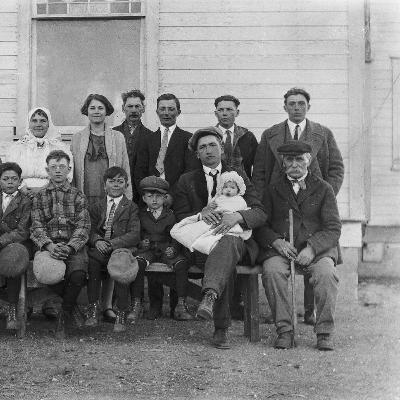1. [onto]Riffology- Explorations
Update: 2021-02-07
Description
[onto]Riffology: Explorations into collaboration, assemblage and learning events
(Published in Ontic Flows: From Digital Humanities to Posthumanities, 2016).
The Riff
What term may be applied to an intuitively formed academic discourse of many years’ length that has been entirely conducted by way of various technologies and functions such as phone, text, email? We call it riff—interactive and freeform. And if we approach it scientifically, we practice Riffology. As we seek to reference our interest in educational ontologies, we prefix it with [onto], which we enclose in brackets to suggest a compound word that’s primacy of focus is placed on the active (action) constituent of “riff” and “riffing.” [onto]Riffology. We have been archiving emails and texts passed between us in an approach to learning that is largely thus: technology facilitated encounters gratifying our embodied curiosities and a becoming curricula without syllabi. Incrementally, we have witnessed our inquiries broaden, understandings multiply, and relationships in assemblage intensify. As educators, students and researchers we believe that there are evolving ways of learning in relationships whereby we simultaneously plug-in technological platforms and facilitate education’s capabilities and capacities.
Contexts and Historicities
In 2009, the Canadian criminal justice system directed its steady gaze on Richard, the federal police investigated, various news media reported and the prospect of incarceration loomed. Societally stigmatized and isolated, while simultaneously mobilizing the material environment, he faced a seemingly inevitable path first towards prisoner, then to becoming eventual prison academic.
Around this time, a university acquaintance became correspondent. Without any physical proximity whatsoever, we two (Richard and Shannon) were first motivated, and eventually compelled, to continue learning in each other's midst. Clips of video (self produced, sourced online), photography, music, song lyrics, online encyclopedic entries and varied text were spliced through “cut and paste” functions to visually reinforce ideas, reference thought and entertain in call(s) and response(s) across technological media.
In 2013, we brought our collaborative approaches to a doctoral program at University of Victoria’s Faculty of Education, where we pursued academic interests in criminology, incarceration, institutions, prison visits, prison education, and the carnivalesque. Our inquiries became subsumed, however, by deepening interest in the process of our engagement; what it’s ever been about, and by what sorcery it could be maximized in its learning engagement. We neither sought to bring together a structuralist account of knowledge, nor to formulate a truth in any unifying theory. Exciting approaches to attribution, technology, arts, mash-up and performance made Remix Theory an attractive area of reading. Richard’s subsequent studies at The European Graduate School in 2014 brought to us concepts from continental philosophy, while University of Victoria faculty pointed us towards qualitative methodologies that might approximate our riffologic interests.
One such methodology was duoethnography, whereby two or more researchers juxtapose their life histories in order to provide multiple understandings of a social phenomenon. Duoethnography possesses qualities similar to those of our riffing; it widely sources emergent themes and the construction of meaning (Sawyer & Norris, 2013), while positioning participants not as topics of the work, but rather as sites of sociocultural inquiry (Sawyer and Liggett, 2012).
(Published in Ontic Flows: From Digital Humanities to Posthumanities, 2016).
The Riff
What term may be applied to an intuitively formed academic discourse of many years’ length that has been entirely conducted by way of various technologies and functions such as phone, text, email? We call it riff—interactive and freeform. And if we approach it scientifically, we practice Riffology. As we seek to reference our interest in educational ontologies, we prefix it with [onto], which we enclose in brackets to suggest a compound word that’s primacy of focus is placed on the active (action) constituent of “riff” and “riffing.” [onto]Riffology. We have been archiving emails and texts passed between us in an approach to learning that is largely thus: technology facilitated encounters gratifying our embodied curiosities and a becoming curricula without syllabi. Incrementally, we have witnessed our inquiries broaden, understandings multiply, and relationships in assemblage intensify. As educators, students and researchers we believe that there are evolving ways of learning in relationships whereby we simultaneously plug-in technological platforms and facilitate education’s capabilities and capacities.
Contexts and Historicities
In 2009, the Canadian criminal justice system directed its steady gaze on Richard, the federal police investigated, various news media reported and the prospect of incarceration loomed. Societally stigmatized and isolated, while simultaneously mobilizing the material environment, he faced a seemingly inevitable path first towards prisoner, then to becoming eventual prison academic.
Around this time, a university acquaintance became correspondent. Without any physical proximity whatsoever, we two (Richard and Shannon) were first motivated, and eventually compelled, to continue learning in each other's midst. Clips of video (self produced, sourced online), photography, music, song lyrics, online encyclopedic entries and varied text were spliced through “cut and paste” functions to visually reinforce ideas, reference thought and entertain in call(s) and response(s) across technological media.
In 2013, we brought our collaborative approaches to a doctoral program at University of Victoria’s Faculty of Education, where we pursued academic interests in criminology, incarceration, institutions, prison visits, prison education, and the carnivalesque. Our inquiries became subsumed, however, by deepening interest in the process of our engagement; what it’s ever been about, and by what sorcery it could be maximized in its learning engagement. We neither sought to bring together a structuralist account of knowledge, nor to formulate a truth in any unifying theory. Exciting approaches to attribution, technology, arts, mash-up and performance made Remix Theory an attractive area of reading. Richard’s subsequent studies at The European Graduate School in 2014 brought to us concepts from continental philosophy, while University of Victoria faculty pointed us towards qualitative methodologies that might approximate our riffologic interests.
One such methodology was duoethnography, whereby two or more researchers juxtapose their life histories in order to provide multiple understandings of a social phenomenon. Duoethnography possesses qualities similar to those of our riffing; it widely sources emergent themes and the construction of meaning (Sawyer & Norris, 2013), while positioning participants not as topics of the work, but rather as sites of sociocultural inquiry (Sawyer and Liggett, 2012).
Comments
In Channel

![1. [onto]Riffology- Explorations 1. [onto]Riffology- Explorations](https://s3.castbox.fm/3e/01/9e/75910f0e67a846844b9fc54f8c6c903c10_scaled_v1_400.jpg)









